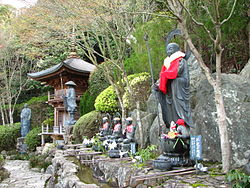- Daishō-in (Miyajima)
-
 Niōmon Gate
Niōmon Gate
Daishō-in or Daisyō-in (大聖院) is a historic Japanese temple on Mt.Misen, the holy mountain in the island of Itsukushima in Miyajima-chō in the city of Hatsukaichi, Hiroshima, Japan. It is the 14th of Chūgoku 33 Kannon Pilgrimage and famous for autumn leaves and maples. It has another temple name called "Suishō-ji" (水精寺). Including Mt.Misen, Daishō-in is within the World Heritage Area of Itsukushima Shrine.
In this temple there is a flame is which is said to have been burning since its foundation, for more than 1200 years.[1][2]
Contents
History
- Daishō-in was founded by the monk Kūkai, also known posthumously as Kōbō-Daishi (弘法大師), in the year 806, the 1st year of the Daidō era.
- Kūkai was one of the most famous monks in Japan and the founder of Shingon Buddhism.
- So, it's the head temple of one of the denominations of Shingon Buddhism and the oldest temple in Itsukushima.
- An Imperial order by Emperor Toba, it was the place to pray for the peace and security of the nation.
- Emperor Meiji was staied on July 31, 1885 for his visit to Itsukushima Shrine.
- Repair work for the trail to Mt.Misen was finished in 1905.
- It was done by the donation of Itō Hirobumi.
- Heavy damage by 19th typhoon on September 27, 1991.
- Held a memorial service to congratulate the restoration of the damage on October 10, 1998.
- The 14th Dalai Lama visited Itsukushima to celebrate the 1200th-year of Daishō-in from the 3rd to 8th of November in 2006.
There are also many buildings, gates of the temple and many statues of Kannon, Jūichimen Kannon, Acala and Seven Lucky Gods on and around Mt.Misen.
Events
See also
- Itsukushima
- Kūkai
- Shingon Buddhism
- Kannon
- Chūgoku 33 Kannon Pilgrimage
- Mt.Misen
- Acala
- Seven Lucky Gods
- For an explanation of terms concerning Japanese Buddhism, Japanese Buddhist art, and Japanese Buddhist temple architecture, see the Glossary of Japanese Buddhism.
References
- ^ Rowthorn, Chris (2009). Lonely Planet Japan. Lonely Planet. p. 470. ISBN 1741790425, 9781741790429. http://books.google.com.mx/books?id=VvPMIV_WNYEC&pg=PA470&dq=Daish%C5%8D-in+flame&hl=es&ei=nEEuTOfoOYWNnQfB26XlAw&sa=X&oi=book_result&ct=result&resnum=1&ved=0CC0Q6AEwAA#v=onepage&q=Daish%C5%8D-in%20flame&f=false. Retrieved 02/07/2010.
- ^ Nihonsankei. "Miyajima". The three most scenic spots in Japan. http://nihonsankei.sakura.ne.jp/eng/miyajima.html. Retrieved 2007-06-25.
External links
34°17′31″N 132°19′07″E / 34.29195°N 132.318475°ECoordinates: 34°17′31″N 132°19′07″E / 34.29195°N 132.318475°E
Buddhist temples in Japan Japanese Buddhist architecture Architectonic elements Mon (gates) Buildings Chinjusha · chōzuya/temizuya · -dō · main hall (kon-dō, hon-dō, butsuden) · kuri · kyōzō or kyō-dō · shoinTō or Buttō (pagodas) Styles Others A-un · kenSchools and objects of worship Major schools Zen schools Nanto rokushū Objects of worship Amida Nyōrai · Benzaiten · Dainichi Nyorai · Jizō · Kannon · Marishi-ten · Shaka Nyorai · Shitennō (Four Kings) · Twelve Heavenly Generals (Jūni Shinshō) · Yakushi NyoraiOther elements Implements kei (ritual gong) · mokugyōOthers bussokuseki · butsudan · Glossary of Japanese Buddhism · Japanese Buddhist pantheon · jingū-ji · miyadera · saisenbakoCategories:- Buddhist temples in Hiroshima Prefecture
- Visitor attractions in Hiroshima Prefecture
- Visitor attractions in Hatsukaichi
- Hiroshima geography stubs
- Buddhism stubs
Wikimedia Foundation. 2010.



